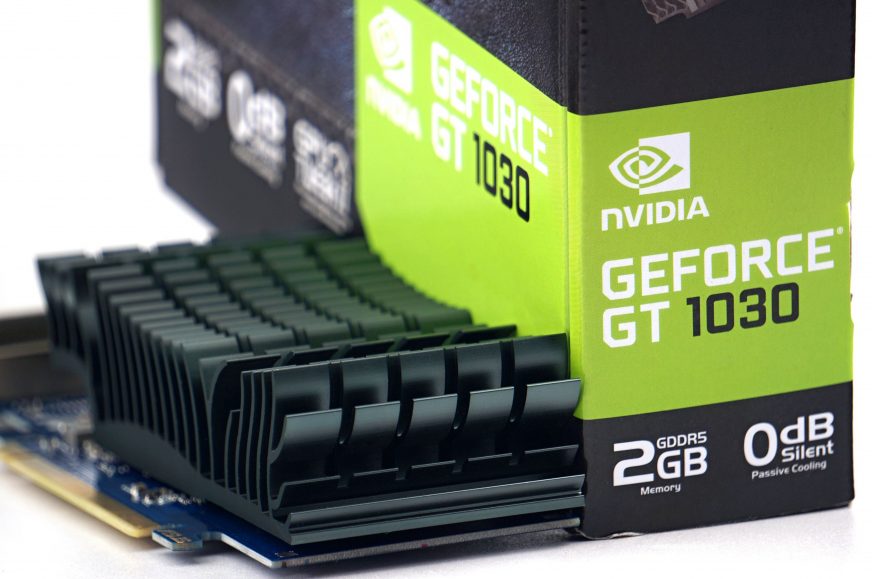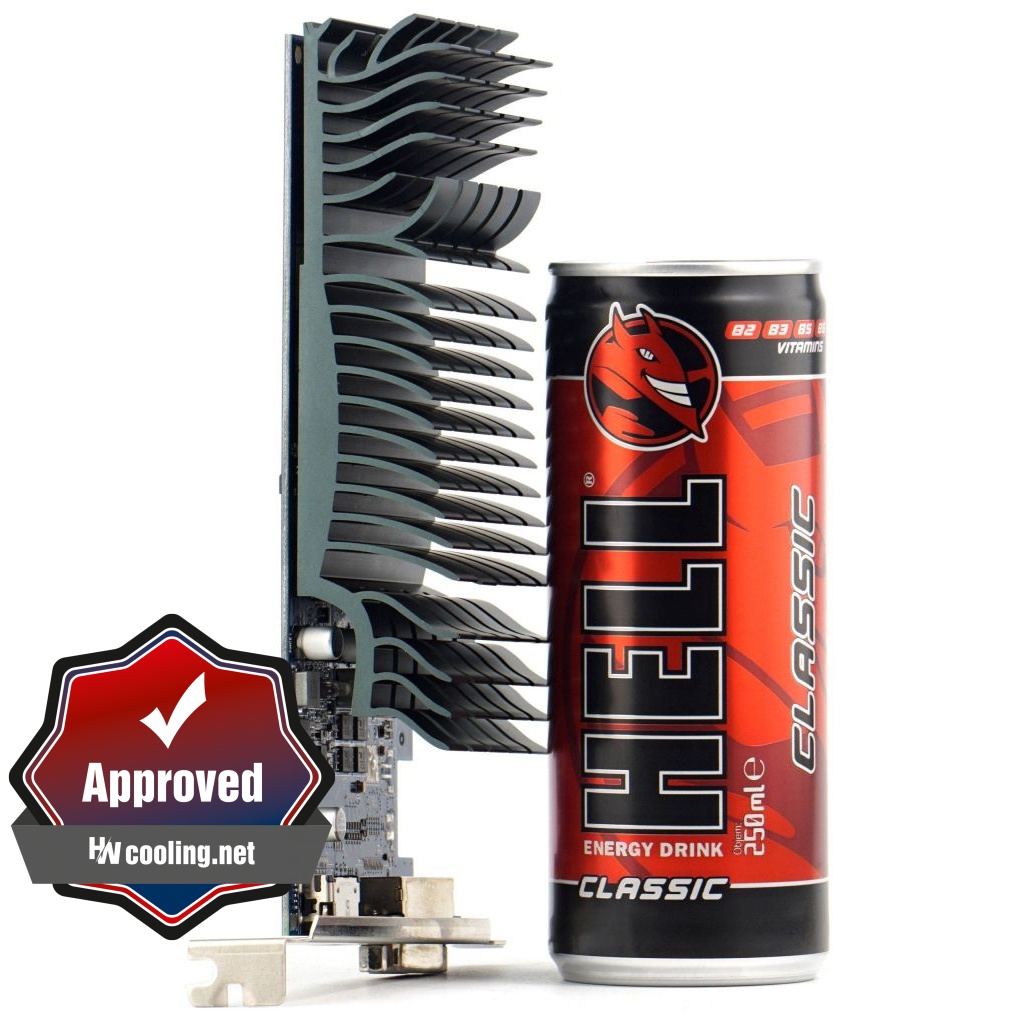Conclusion
Low-end graphics cards cannot be misused to mine cryptocurrencies. Their performance is too weak for that and therefore they sadly sit in warehouses. As a result, they also keep low prices. We’re talking about the GeForce GT 1030, which is the only option at a reasonable price for regular users who do not have an iGPU. We’ll see how this little graphics card performs across the tests. For whom does it make sense and for whom does it not?
Conclusion
If there’s a place where the GT 1030 would be perfect, it’s HTPC. Power consumption when playing HEVC and VP9 videos is extremely low. Compared to the RTX 3060, it’s less than 1/2 and, for example, the more powerful Radeon RX 6000 cards consume up to 4–6 times more. This also applies to browsing the accelerated web, and consumption is extremely low when off-load or when working with text and spreadsheet editors. The Asus GT 1030 SL 2G BRK gets the green light for office computers.
Thanks to the passive cooler, it can also be a great choice for powerful, but quietly optimized workstations. Typically built on Intel HEDT or AMD Threadripper platforms, which do not have their own iGPU. But only in cases where you do not expect anything from the graphics card and all computing performance depends on the CPU. The GT 1030 is very weak for any computations, it doesn’t even have its own encoder and the performance of the 384 shaders is really only for emergency home editing.
Performance in Photoshop is also significantly slower than usual. For purposes such as photo editing or 2D graphics as well as any other computational tasks that you are at least a little serious about, the GT 1030 is an inappropriate choice.
No matter how slow the GT 1030 is, it is still faster than a processor iGPU. For weaker graphics cards, we have created a new test environment with a resolution of 1366 × 768 px and medium graphics settings. But we also test in Full HD on Ultra settings, where there is an intersection with high performance graphics cards. And some games are quite playable even with these settings. Such as Age of Empires: Definitive Edition or FIFA 21 reach almost 50 fps on average and 28+ fps is in Wasteland 3. CS:GO runs smoothly above 90 fps.
But then there are games that you can’t play with the GT 1030 even after lowering the resolution and details. These include Assassin’s Creed: Valhalla, Metro Exodus or Shadow of the Tomb Raider. Cyberpunk 2077 is also close, with Fidelity FX at 50% upscaling in 768p you can get it over 30 fps. But this is at the expense of a terrible visual quality, which will surely make it disgusting even for undemanding players.
Battlefield V, F1 2020, Total War Saga: Troy, but also DOOM Eternal and Red Dead Redemption 2 can get from unplayable to nicely playable by lowering the settings. You won’t be even able to make a save in DOOM and RDR2 in higher resolution or higher graphics settings due to 2 GB of VRAM.
GPU frequencies exceed the specified boost value with 1730–1760 MHz by more than 250 MHz. Power consumption stays just below 30 W TDP (28.8–29.9 W) and you don’t need to worry about the temperature either, which will always be low in at least moderately cooled cases, despite the passive cooler. The coils are relatively quiet – we measured the noise level as standard in all modes, even if the cooler does not have a fan. It makes some noise, of course. You can also study its detailed analysis in the chapter with measurements of frequency response.
The Asus GT 1030 SL 2G BRK can currently be purchased for around € 100. This card may have been cheaper, but it’s still better than nothing or paying double the price for a low-end.
| Asus GT 1030 SL 2G BRK |
| + Very low power consumption in multimedia and office tasks |
| + You can also play less demanding games smoothly in FHD resolution with high details |
| + 250 MHz higher GPU frequencies than specified |
| + Efficient passive heatsink and low GPU temperature |
| + HDMI 2.0b (4K at 60 Hz) |
| + Supplied PCIe half-sized blanking plate for 1U server PC cases |
| +Exclusive CUDA support, albeit with a controversial benefit |
| + One of the few available (and affordable) graphics cards |
| - No hardware encoder (NVENC). Competing iGPU Intel (Quick Sync) and AMD (VCE) do have one |
| - Possible collision of the higher heatsink in smaller computers |
| - Bare VRM and memory without additional cooling |
| - Weaker price/performance ratio |
| Manufacturer's suggested retail price: EUR 100/CZK 2,547 |
We’ve got the games for our tests from Jama levova
- Contents
- Asus GT 1030 SL 2G BRK in detail
- Table of specifications
- Methodology: performance tests
- Methodology: how we measure power draw
- Methodology: noise and sound measurement
- Test rig
- 3DMark
- Age of Empires II: DE
- Assassin’s Creed: Valhalla
- Battlefield V
- Borderlands 3
- Control
- Counter-Strike: GO
- Cyberpunk 2077
- Cyberpunk 2077 with FidelityFX CAS
- DOOM Eternal
- F1 2020
- FIFA 21
- Forza Horizon 4
- Mafia: DE
- Metro Exodus
- Microsoft Flight Simulator
- Red Dead Redemption 2 (Vulkan)
- Red Dead Redemption 2 (Dx12)
- Shadow of the Tomb Raider
- Total War Saga: Troy
- Wasteland 3
- CompuBench (OpenCL)
- CompuBench (CUDA)
- SPECviewperf 2020 and SPECworkstation 3
- FLOPS, IOPS and memory speed tests
- 3D rendering 1/2 (LuxMark and Blender@Cycles)
- 3D rendering 2/2 (Blender@Radeon ProRender and Eevee)
- Photo editing (Adobe Photoshop, Lightroom and Affinity Photo)
- Password cracking
- GPU clock speed
- GPU temperature
- Net graphics power draw
- Analysis of 12 V subcircuit power supply (higher load)
- Analysis of 12 V subcircuit power supply (lower load)
- Analysis of 3.3 V subcircuit power supply
- Noise level
- Frequency response of sound
- Conclusion













